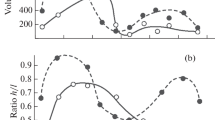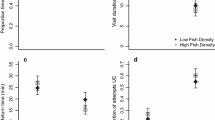Abstract
A model to explain the behavioural mechanisms underlying the fountain manoeuvre, a predator-evasion response shown by fish shoals is tested. It is proposed that the responses of individual fish are constrained by requirements to (1) visually monitor the predator's behaviour, (2) minimise the energetic cost of escape, and (3) maximise the rate of passage around the predator. The model predicts that individuals will swim away from the threat at a constant angle determined by the rear limit of the visual field and that the range of reaction will be constrained by water visibility. The model's predictions were upheld in tests conducted in 1984 using a shoal of juvenile whiting, Merlangius merlangus (L.). It is concluded that the principal determinant of the fountain manoeuvre is the visual field of the fish.
Similar content being viewed by others
Literature cited
Black, E. C.: Energy stores and metabolism in relation to muscular activity in fishes. In: The investigation of fish-power problems, pp 51–67. Ed. by P. A. Larkin. British Columbia: University of British Columbia Press 1958. (H. R. MacMillan Lectures in Fisheries)
Bogatyrev, P. B.: Certain elements of the spatial vision of fishes. In: Biological bases for controlling fish behaviour, pp 192–206. Ed. by B. P. Monteifel. Moscow: Akademii Nauk SSSR (Institute of Evolutionary Morphology and Animal Ecology) 1970
Breder, C. M.: Studies on the structure of the fish shoal. Bull. Am. Mus. nat. Hist. 98, 7–28 (1951)
Breder, C. M.: Studies on the social groupings of fish. Bull. Am. Mus. nat. Hist. 117, 397–481 (1959)
Eaton, R. C., R. A. Bombadieri and D. L. Meyer: The Mauthnerinitiated startle response in teleost fish. J. exp. Biol. 66, 65–81 (1977)
Hawkins, A. D.: The sensivity of fish to sounds. Oceanogr. mar. Biol. A. Rev. 11, 291–340 (1973)
Major, P. F.: Predator-prey interactions in shoaling fishes during periods of twilight: a study of the silverside Pranesus insularum in Hawaii. Fish. Bull. U.S. 75, 415–426 (1976)
Neill, S. R., St. J., Cullen and M. J. Cullen: Experiments on whether shoaling by their prey affects the hunting behaviour of cephalopod and fish predators. J. Zool., Lond. 172, 549–569 (1974)
Nursall, J. R.: Some behavioural interactions of the spottail shiver (Notropis hudsonius), yellow perch (Perca faluvescens), and Northern pike (Esox lucius). J. Fish. Res. Bd Can. 30, 1161–1178 (1973)
Pitcher, T. J.: The role of shoaling in fish capture. Int. Counc. Explor. Sea Comm. Meet. (Pelagic Fish Comm.) 1979/B, 1–17 (1979)
Pitcher, T. J.: Functions of shoaling behaviour in teleosts. In: The behaviour of teleost fishes, Chapter 12. pp 294–337. Ed. by T. J. Pitcher. London: Croom Helm 1985
Pitcher, T. J. and C. J. Wyche: Predator-avoidance behaviours of sand-eel shoals: why shoals seldom split. In: Predators and prey in fishes, pp 193–204. Ed. by D. L. G. Noakes et al. The Hague: W. Junk 1983
Poole, T. B. and N. Dunstone: Underwater predatory behaviour of the American mink Mustela vison. J. Zool., Lond. 178, 395–412 (1976)
Potts, G. V. N.: The shoaling ethology of Lutjianus monostigma in the shallow reef environment of Aldabra. J. Zool., Lond. 101, 223–235 (1970)
Shaw, E.: Shoaling in fishes: critique and review. In: Development and evolution of behaviour, pp 452–480. Ed. by L. R. Aronson et al. San Francisco: Freeman 1970
Walls, G. L.: The vertebrate eye and its adaptive radiation. Bull. Cranbrook Inst. Sci. 19, 375–376 (1942)
Wardle, C. S.: Effects of size on swimming speeds of fish. In: Scale effects in animal locomotion, pp 299–313. Ed. by T. J. Pedley. London: Academic Press 1977
Wardle, C. S.: Fish behaviour and fishing gears. In: The behaviour of teleost fishes, Chapter 18. pp 463–495. Ed. by T. J. Pitcher. London: Croom Helm 1985
Zottoli, S. J.: Correlation of the startle reflex and mauthner cell auditory responses in unrestrained goldfish. J. exp. Biol. 66, 243–254 (1977)
Author information
Authors and Affiliations
Additional information
Communicated by J. Mauchline, Oban
Rights and permissions
About this article
Cite this article
Hall, S.J., Wardle, C.S. & MacLennan, D.N. Predator evasion in a fish school: test of a model for the fountain effect. Mar. Biol. 91, 143–148 (1986). https://doi.org/10.1007/BF00397579
Accepted:
Issue Date:
DOI: https://doi.org/10.1007/BF00397579




